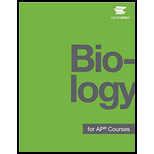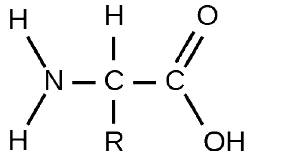
BIOLOGY FOR AP COURSES (OER)
17th Edition
ISBN: 9781947172401
Author: OpenStax
Publisher: OpenStax
expand_more
expand_more
format_list_bulleted
Concept explainers
Textbook Question
Chapter 3, Problem 23CTQ
Amino acids have the generic structure seen below, where R represents different carbon-based  side chains.
side chains.
Describe how the structure of amino acids allows them to be linked into long peptide chains to form proteins.
Expert Solution & Answer
Trending nowThis is a popular solution!

Students have asked these similar questions
I have the first half finished... just need the bottom half.
13. Practice Calculations: 3 colonies were suspended in the following dilution series and then a
viable plate count and microscope count was performed. Calculate IDF's, TDF's and then
calculate the CFU/mL in each tube by both methods. Finally calculate the cells in 1 colony by
both methods. Show all of your calculations in the space provided on the following pages.
3 colonies
56
cells
10 μL
10 μL
100 μL
500 με
m
OS
A
B
D
5.0 mL
990 με
990 με
900 με
500 μL
EN
2
100 με
100 μL
118
colonies
12
colonies
Describe and give a specific example of how successionary stage is related to species diversity?
Chapter 3 Solutions
BIOLOGY FOR AP COURSES (OER)
Ch. 3 - Figure 3.5 What kind of sugars are these, aldose...Ch. 3 - Figure 3.23 Which categories of amino acid would...Ch. 3 - Figure 3.33 A mutation occurs, and cytosine is...Ch. 3 - Dehydration synthesis leads to formation of...Ch. 3 - During the breakdown of polymers, which of the...Ch. 3 - The following chemical reactants produce the ester...Ch. 3 - An example of a monosaccharide is fructose glucose...Ch. 3 - Cellulose and starch are examples of:...Ch. 3 - Plant cell walls contain which of the following in...Ch. 3 - Lactose is a disaccharide formed by the formation...
Ch. 3 - Which of the following is not an extracellular...Ch. 3 - Saturated fats have all of the following...Ch. 3 - Phospholipids are important components of...Ch. 3 - Cholesterol is an integral part of plasma...Ch. 3 - The monomers that make up proteins are called...Ch. 3 - The helix and the pleated sheet are part of...Ch. 3 - Mad cow disease is an infectious disease where one...Ch. 3 - A nucleotide of DNA may contain. ribose, uracil,...Ch. 3 - The building blocks of nucleic acids are ____. a....Ch. 3 - How does the double helix structure of DNA support...Ch. 3 - Why are biological macromolecules considered...Ch. 3 - What role do electrons play in dehydration...Ch. 3 - Amino acids have the generic structure seen below,...Ch. 3 - Describe the similarities and differences between...Ch. 3 - Why is it impossible for humans to digest food...Ch. 3 - Draw the ketose and aldose forms of a...Ch. 3 - Explain at least three functions that lipids serve...Ch. 3 - Why have trans fats been banned from some...Ch. 3 - Why are fatty acids better than glycogen for...Ch. 3 - Part of cortisol’s role in the body involves...Ch. 3 - Explain what happens if even one amino acid is...Ch. 3 - Describe the differences in the four protein...Ch. 3 - Aquaporins are proteins embedded in the plasma...Ch. 3 - What are the structural differences between RNA...Ch. 3 - What are the four types of RNA and how do they...
Additional Science Textbook Solutions
Find more solutions based on key concepts
Show the steps in the synthesis of the tetrapeptide in Problem 34, using Merrifields method.
Organic Chemistry (8th Edition)
1. ___ Mitosis 2. ___ Meiosis 3. __ Homologous chromosomes 4. __ Crossing over 5. __ Cytokinesis A. Cytoplasmic...
Microbiology with Diseases by Body System (5th Edition)
Fill in the blanks: a. The wrist is also known as the _________ region. b. The arm is also known as the _______...
Human Anatomy & Physiology (2nd Edition)
What percentage of Earths land surface do glaciers presently cover? ____________
Applications and Investigations in Earth Science (9th Edition)
Distinguish between microevolution, speciation, and macroevolution.
Campbell Essential Biology (7th Edition)
Use the key to classify each of the following described tissue types into one of the four major tissue categori...
Anatomy & Physiology (6th Edition)
Knowledge Booster
Learn more about
Need a deep-dive on the concept behind this application? Look no further. Learn more about this topic, biology and related others by exploring similar questions and additional content below.Similar questions
- Explain down bellow what happens to the cell in pictures not in words: Decreased pH in mitochondria Increased ATP Decreased pH in cytosol Increased hydrolysis Decreasing glycogen and triglycerides Increased MAP kinase activity Poor ion transport → For each one:→ What normally happens?→ What is wrong now?→ How does it mess up the cell?arrow_forward1.) Community Diversity: The brown and orange line represent two different plant communities. a. Which color represents the community with a higher species richness? b. Which color represents the community with a higher species evenness? Relative abundance 0.1 0.04 0.001 2 4 6 8 10 12 14 16 18 20 22 24 Rank abundance c. What is the maximum value of the Simpson's diversity index (remember, Simpson's index is D = p², Simpson's diversity index is 1-D)? d. If the Simpson's diversity index equals 1, what does that mean about the number of species and their relative abundance within community being assessed?arrow_forward1.) Community Diversity: The brown and orange line represent two different plant communities. a. Which color represents the community with a higher species richness? b. Which color represents the community with a higher species evenness? Relative abundance 0.1 0.04 0.001 2 4 6 8 10 12 14 16 18 20 22 24 Rank abundance c. What is the maximum value of the Simpson's diversity index (remember, Simpson's index is D = p², Simpson's diversity index is 1-D)? d. If the Simpson's diversity index equals 1, what does that mean about the number of species and their relative abundance within community being assessed?arrow_forward
- what measures can a mother to take to improve the produce of her to milk to her newborn baby ?arrow_forward1. Color the line that represents all ancestors of the Eastern white pine tree green (but only the ancestral line NOT shared with other organisms) 2. Oncle the last common ancestor of the Colorado blue spruce tree and Eastern white pine tree. 3. Put a box around the last common ancestor of the sugar maple tree and the dogwood tree. 4. Put a triangle around the last common ancestor of the red pine tree and the american holly bush. 5. Color the line that represents all ancestors of the Ponderosa pine tree red (including all shared ancestors). 6. Color the line that represents all ancestors of the American elm tree blue (including all shared ancestors). 7 Color the line that represents all ancestors of the Sabal palm tree purple (including all shared ancestors) 8. Using a yellow highlighter or colored pencil, circle the clade that includes all pine trees. 9. Using a orange highlighter or colored pencil, circle the clade that includes all gymnosperms 10. Can you tell…arrow_forwardYou have been hired as a public relations specialist to give invertebrates a good name. After all, they are much more than just creepy crawly bugs! Your first task though is to convince yourself that is true. The best way to do that is to start close to home. Find something in your house that is a product obtained directly from an invertebrate or only due to an invertebrate’s actions. Describe the product, its function and utility, as well as any human manufactured alternatives. Be sure to highlight the advantages of obtaining this directly from nature. Keep in mind, a product can be something you use, wear, eat, or enjoy for its visual appeal.arrow_forward
- Use the following tree diagram to answer Questions #8-10. 8) Which of the following two animals are the most closely related based on the tree to the left? a) Pig and camel b) Hippo and pig c) Deer and cow 9) CIRCLE on the tree diagram where the common ancestor between a hippo and a cow is. 10) Put a SQUARE on the tree diagram where the common ancestor between a pig and a peccary is.arrow_forwardExplain: Healthy Cell Function Overview→ Briefly describe how a healthy cell usually works: metabolism (ATP production), pH balance, glycogen storage, ion transport, enzymes, etc. Gene Mutation and Genetics Part→ Focus on the autosomal recessive mutation and explain: How gene mutation affects the cell. How autosomal inheritance works. Compare the normal and mutated gene sequences simply. → Talk about possible consequences of a faulty hydrolytic enzyme.arrow_forwardCan you fill out those termsarrow_forward
- Explain down bellow what happens to the cell: Decreased pH in mitochondria Increased ATP Decreased pH in cytosol Increased hydrolysis Decreasing glycogen and triglycerides Increased MAP kinase activity Poor ion transport → For each one:→ What normally happens?→ What is wrong now?→ How does it mess up the cell?arrow_forwardAn 1100 pound equine patient was given 20 mg/kg sucralfate 3 times a day, 2.8 mg/kg famotidine twice a day, and 10mg/kg doxycycline twice a day. Sucralfate comes as a 1 gm tablet, famotidine as 20 mg tablets, and doxycycline as 100mg tablets. All are in bottles of 100 tablets.How many total mg are needed for the patient and how many tablets of each would be needed to provide each dose?How many bottles of each would be needed to have available if this patient were to be on this drug regimen for 5 days?arrow_forwardThe patient needs a solution of 2.5% dextrose in Lactated Ringer’s solution to run at 75 ml/hr for at least the next 12hours. LRS comes in fluid bags of 500 ml, 1 Liter, 3 Liters and 5 Liters. How can a 2.5% solution be made by adding50% dextrose to the LRS?arrow_forward
arrow_back_ios
SEE MORE QUESTIONS
arrow_forward_ios
Recommended textbooks for you
 Biology (MindTap Course List)BiologyISBN:9781337392938Author:Eldra Solomon, Charles Martin, Diana W. Martin, Linda R. BergPublisher:Cengage Learning
Biology (MindTap Course List)BiologyISBN:9781337392938Author:Eldra Solomon, Charles Martin, Diana W. Martin, Linda R. BergPublisher:Cengage Learning Human Heredity: Principles and Issues (MindTap Co...BiologyISBN:9781305251052Author:Michael CummingsPublisher:Cengage Learning
Human Heredity: Principles and Issues (MindTap Co...BiologyISBN:9781305251052Author:Michael CummingsPublisher:Cengage Learning
 Concepts of BiologyBiologyISBN:9781938168116Author:Samantha Fowler, Rebecca Roush, James WisePublisher:OpenStax College
Concepts of BiologyBiologyISBN:9781938168116Author:Samantha Fowler, Rebecca Roush, James WisePublisher:OpenStax College Human Biology (MindTap Course List)BiologyISBN:9781305112100Author:Cecie Starr, Beverly McMillanPublisher:Cengage Learning
Human Biology (MindTap Course List)BiologyISBN:9781305112100Author:Cecie Starr, Beverly McMillanPublisher:Cengage Learning Biology Today and Tomorrow without Physiology (Mi...BiologyISBN:9781305117396Author:Cecie Starr, Christine Evers, Lisa StarrPublisher:Cengage Learning
Biology Today and Tomorrow without Physiology (Mi...BiologyISBN:9781305117396Author:Cecie Starr, Christine Evers, Lisa StarrPublisher:Cengage Learning

Biology (MindTap Course List)
Biology
ISBN:9781337392938
Author:Eldra Solomon, Charles Martin, Diana W. Martin, Linda R. Berg
Publisher:Cengage Learning

Human Heredity: Principles and Issues (MindTap Co...
Biology
ISBN:9781305251052
Author:Michael Cummings
Publisher:Cengage Learning


Concepts of Biology
Biology
ISBN:9781938168116
Author:Samantha Fowler, Rebecca Roush, James Wise
Publisher:OpenStax College

Human Biology (MindTap Course List)
Biology
ISBN:9781305112100
Author:Cecie Starr, Beverly McMillan
Publisher:Cengage Learning

Biology Today and Tomorrow without Physiology (Mi...
Biology
ISBN:9781305117396
Author:Cecie Starr, Christine Evers, Lisa Starr
Publisher:Cengage Learning